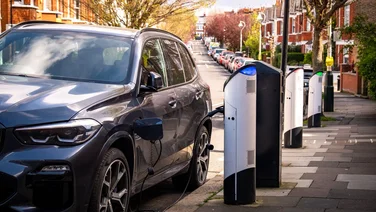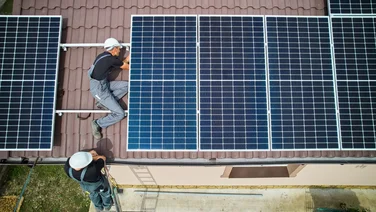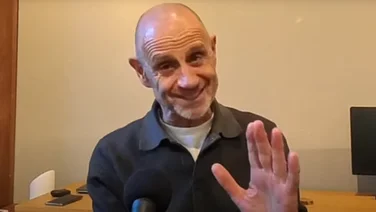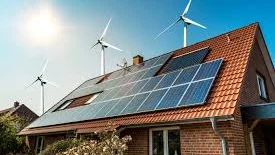- Is renewable energy cheaper than fossil fuels?
- What is the cheapest source of renewable energy?
- Cost of renewable energy vs fossil fuels
- Why is renewable energy cheaper than fossil fuels?
- Why are energy prices rising if renewable energy is getting cheaper?
- Will renewable energy continue getting cheaper?
- Will the UK be using more renewable energy?
- Summary
- Some types of renewable energy are cheaper than fossil fuels
- Global consumption of coal is projected to decline by 13.5% by 2030
- Solar power is the cheapest source of energy and the planet
- Renewable energy is better for the environment, safer for local communities and reduces air pollution
Global annual renewable additions increased by almost 50% to nearly 510 gigawatts (gW) in 2023, the fastest growth rate in the past two decades.
Renewable capacity hit all-time highs in Europe, the United States and Brazil, but Chinas acceleration was extraordinary, as reported by the International Energy Agency (IEA).
For context, in 2023, China commissioned as much solar PV as the rest of the world in 2022, while its wind additions grew by 66% year on year. Globally, solar PV alone accounted for three-quarters of renewable capacity additions worldwide.
This is great news for global emissions, especially as fossil fuels continue to decline. Its worth noting that currently coal is the only fossil fuel projected to decline over the next decade. According to Forbes, global coal consumption is projected to decline by 13.5% by 2030, which is based on a prediction of major growth in renewables and electric vehicles by 2030.
UK greenhouse gas emissions continue to fall, though, with the country now half way to net zero as emissions have been cut by 53% between 1990 and 2023.
There are several reasons why renewable energy is booming in popularity, but one of the most important reasons is its affordability.
But which renewable energy sources are the cheapest, and how does it compare to fossil fuels? Lets find out.

Is renewable energy cheaper than fossil fuels?
Renewable energy is cheaper than new and existing fossil fuels plants. The IEA reported that in 2023, an estimated 96% of newly installed, utility-scale solar PV and onshore wind capacity had lower generation costs than new coal and natural gas.
Three-quarters of these new wind and solar PV plants offered cheaper power than existing fossil fuel facilities. The good news is that renewable energy is only set to get even more affordable from here on out.
As renewable energy continues to get cheaper year-on-year, fossil fuels are actually getting more expensive. The price of fuel, for example, has jumped in the past three years – which is due, in part, to the rise of wholesale price and the war in Ukraine.
Experts are suggesting that switching to renewables can help the global economy, especially following increases in inflation. In fact, a 2022 study from Oxford University found that switching from fossil fuels to renewable energy could save the world as much as $12 trillion (£10.2 trillion) by 2050.
Our latest research shows scaling-up key green technologies will continue to drive their costs down, and the faster we go, the more well save, Dr Rupert Way, the reports lead author from the Smith School of Enterprise and the Environment told the BBC in 2022.
Our central conclusion is that we should go full speed ahead with the green energy transition because its going to save us money.
If you want to discover the most-effective types of green energy, check out our page: Which renewable energy is the best?
What is the cheapest source of renewable energy?
Solar, onshore and offshore wind are the cheapest sources of renewable energy, with solar leading the way. Solar became the most affordable renewable energy in history in 2021, after it became cheaper than gas.
PV module prices have fallen by around 80% since 2010. Prices have stagnated post-Covid-19, however, but they are expected to fall again in 2024.
Although commodity and freight prices have dropped from last years peaks, they remain elevated, the IEA reported in October 2023. At the same time, developers financing costs have increased due to rising interest rates.
As a result, global average levelised costs of energy for onshore wind and solar PV are expected to remain 10-15% above 2020 levels in 2024.
Overall, solar and onshore wind remain the cheapest option for new electricity generation in most countries. The IEA claims that continued innovation is also expected to reduce costs further, improving competitiveness even with existing fossil fuel-fired plants.
Solar panels themselves have also become more affordable over time, with the average household able to install 10 panels for £7,026. Research by IRENA found that the cost of crystalline solar PV modules sold in Europe declined by around 91% between 2009 and 2022.
And as solar energy costs continue to decline, more people will invest – especially as it enables them to lower their monthly cost.
Check out the chart below to get an idea of how much solar compares to other sources of energy.
Data from Our World in Data, 2020
Cost of renewable energy vs fossil fuels
Because renewable energy continues to fall – even gradually – the cost of fossil fuels will become more expensive.
If we look at UK fuel pricing as an example, youll see that petrol and diesel prices are almost at an all-time high. While prices peaked in July 2022 reaching highs of £1.98 per litre for diesel and £1.89 per litre for petrol, they are still double what they were a decade ago.
On average – according to the RAC Foundation – diesel prices currently (April 2024) sit in the region of £1.56 per litre and petrol is £1.47. In 2004, the average price was 86p for diesel per litre, while petrol was 82.73p.
This price hike is attributed in part to the gas shortage in 2021 following the Covid-19 pandemic and Russias invasion of Ukraine in February 2022.
But when it comes to the cheapest fuel on the planet, gas and solar have been neck and neck for some time. As mentioned above, however, solar finally took over gas as the cheapest energy source in the world.
Data from IRENA, 2022
This dramatic decrease in cost is something we can see across several renewable energy sources. The graphic below outlines how much the cost of solar and wind have changed over time. Generally, we expect this trend to continue in most countries – but the cost of renewable energy and fossil fuels will fluctuate, depending on where youre located.
For example, IRENA suggests the low-cost era of fossil gas ended in 2004, which means the continent has seen the benefits of cheap renewable energy more.
Why is renewable energy cheaper than fossil fuels?
Renewable energy sources run at a lower cost because they dont require fuel to run. Fossil fuel plants, however, require various fuels like coal, oil and natural gas, which can be expensive.
Fuel costs also fluctuate – as outlined above – which can make it difficult to predict operating costs, unlike renewable energy sources.
Technology advancements also affect the cost of renewable energy. These advancements have made solar panels more efficient at converting sunlight into electricity, while wind turbines are more efficient at capturing wind energy.
The competition among renewable energy providers has helped to drive down costs. This is further boosted through government grants, schemes and incentives. To find out more about different solar grants and eligibility, visit our guide: How to get UK government grants and funding for solar panels in 2024.
We also need to factor in environmental costs, which arent always reflected in the price. Fossil fuels generate costs in the form of air pollution, water pollution, and greenhouse gas emissions. Renewable energy, however, actively works to remove or lower these, making it a more attractive option for consumers.

Why are energy prices rising if renewable energy is getting cheaper?
The cost of energy has risen across the world. In the UK, energy prices remained stable or fell between 2013 to 2020 and started to increase in 2021. For example, the average gas bill in 2021 was £564 compared to £700 in 2014.
As inflation began to increase, the energy price cap increased by 12% in October 2021, 54% in April 2022 and was due to increase by 80% in October 2022. More specifically, this meant a 91% increase to gas costs.
Consumers didnt quite pay for this increase, thanks to the Energy Price Guarantee. It meant people paid less for gas from 1 October 2022 compared to the original prediction for Q4 2022. However, up until June 2023, gas and electric was still 27% above the summer 2022 price cap.
Check out the table below to see just how much the cost of electricity per kWh has increased over the past decade.
In recent years, weve also experienced a gas shortage – as outlined above. However, this is only partly to blame for rising wholesale costs.
Why are energy prices rising – causing high energy bills – even though we are consuming more renewable energy than ever before? Ultimately, it comes down to increasing demand.
Competitive electricity markets are experiencing the largest price rises because they rely on the most expensive generator to set the price, as noted by Professor Michael Grubb from UCL Bartlett School of Environment, Energy & Resources.
This is because gas generators can also quickly burn more or less to match temporary spikes in demand for electricity during a day. Currently, most renewables, including solar and wind, cannot be increased on demand as they are intermittent and depend on favourable weather conditions, according to Gov.uk.
This is why the UK continues to use gas over renewable energy. Renewable and nuclear generation is not yet enough to meet total demand, gas is used to provide two fifths of electricity generation, according to Gov.uk.
So despite almost half of its energy mix coming from renewables, the UK continues to experience some of the most expensive energy bills in the world because its energy market is determined by gas.
We only need to look at Scotland to see that more needs to be done. Despite generating electricity with almost 100% renewable energy (including exports), Scotland continues to experience some of the most expensive energy bills in Europe.
Want to learn more? Check out our page: Why Scotland should have cheaper electricity than England.
Will renewable energy continue getting cheaper?
By 2030, technology advancements and improvements could slash prices by a quarter for wind and by half for solar, according to a report – titled X-Change: Electricity – by clean energy think tank, RMI. The report was published in partnership with the Bezos Earth Fund, Global Optimism, and Systems Change Lab.
However, the UK and the world will need to bring the energy market up to speed to ensure its suitable for renewable energy. Achieving this will mean overall energy costs will become cheaper quicker.
Research from Professor Grubb proposes a green power pool, which would involve combining long-term contracts with renewable energy generators – like Contracts for Difference – and selling that on to consumers. This essentially means the price of energy would mainly be set by the actual investment costs of generators, rather than gas-driven wholesale markets.
Will the UK be using more renewable energy?
The government has set a goal of reaching net zero emissions by 2050, and a large portion of their plan involves switching from fossil fuels to renewables.
Right now, the UK has shown a reduction of 53% between 1990 and 2023 – down 5% from 2022.
After becoming the first major economy to halve its emissions, territorial GHG emissions fell further across several key sectors between 2022 and 2023 as the reliance on gas decreases.
The electricity supply sector saw a drop in emissions of 19.6%, homes had a fall of 7.2% and industry had a 8% drop. The latest stats reflect the UK’s world leading record on renewable electricity – with the five largest operational offshore wind farm projects, and nearly half of its electricity generation now comes from renewables compared to just 7% in 2010.
The latest figures show the UK has reduced its its territorial greenhouse gas emissions by 428 MtCO2e between 1990 and 2023 more than the combined emissions reductions from the US, Canada, France, Italy and Japan between 1990 and 2021.
Former energy security secretary, Claire Coutinho, said: “This latest drop in our emissions follows the UK’s achievement in becoming the first major economy to halve its polluting carbon emissions.
“We have done all this while growing our economy by 80%, and shielding families from unnecessary costs.”
Summary
- There are so many benefits to renewable energy. Its better for the environment, safe for local communities, reduces air pollution and its much cheaper than fossil fuels
- Youll benefit in the long run with lower monthly costs – especially since the cost of renewable energy is decreasing across the world
- Countries with a lot of sunshine hours can harness solar energy, famously windy nations can utilise wind energy, and regions with lots of rivers can invest in hydropower
- And as renewable energy continues to get cheaper, its only a matter of time before more countries adopt more of these green sources of energy into their energy mix.







